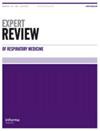The prevalence of oropharyngeal dysphagia in patients with chronic obstructive pulmonary disease: a systematic review and meta-analysis
IF 2.9
3区 医学
Q2 RESPIRATORY SYSTEM
引用次数: 2
Abstract
ABSTRACT Background Oropharyngeal dysphagia (OD) in chronic obstructive pulmonary disease (COPD) patients seriously influence the long-term prognosis of COPD patients. The aim of this study was to assess the prevalence and risk factors of OD in patients with COPD through a systematic review and meta-analysis of observational studies. Methods We identified all observational studies on the prevalence of OD in COPD patients by searching PubMed, Embase, the Cochrane Library, Web of Science, Cumulative Index to Nursing and Allied Health Literature (CINAHL), China National Knowledge Infrastructure (CNKI), the China Biomedical Literature Service System (CBM), the Wanfang Database, and the WeiPu (VIP) databases from database establishment to 1 December 2020. Results Results of the meta-analysis showed that the prevalence of OD in COPD patients was 32.7% (95%CI=30.1, 35.4, I2=91.5%). Dyspnea, gastroesophageal reflux disease(GERD), xerostomia, sputum bacteria, poor physical capacity, poor quality of life, and high CRP level are the risk factors for OD in COPD patients. Conclusion : The prevalence of OD in COPD patients is high. There were some differences in OD among COPD patients with different sex, ages, continents, evaluation methods, patient source and COPD exacerbation.慢性阻塞性肺疾病患者口咽吞咽困难的患病率:系统回顾和荟萃分析
背景慢性阻塞性肺疾病(COPD)患者口咽吞咽困难(OD)严重影响COPD患者的长期预后。本研究的目的是通过对观察性研究的系统回顾和荟萃分析,评估COPD患者OD的患病率和危险因素。方法通过检索PubMed、Embase、Cochrane图书馆、Web of Science、护理与相关健康文献累积索引(CINAHL)、中国知网(CNKI)、中国生物医学文献服务系统(CBM)、万方数据库和微普(VIP)数据库,从数据库建立到2020年12月1日,确定所有COPD患者OD患病率的观察性研究。meta分析结果显示,COPD患者的OD患病率为32.7% (95%CI=30.1, 35.4, I2=91.5%)。呼吸困难、胃食管反流病(GERD)、口干、痰菌、体能差、生活质量差、CRP水平高是COPD患者发生OD的危险因素。结论:慢性阻塞性肺病患者的OD患病率较高。不同性别、年龄、大洲、评价方法、患者来源、COPD加重程度的COPD患者OD存在一定差异。
本文章由计算机程序翻译,如有差异,请以英文原文为准。
求助全文
约1分钟内获得全文
求助全文
来源期刊

Expert Review of Respiratory Medicine
RESPIRATORY SYSTEM-
CiteScore
6.80
自引率
2.60%
发文量
90
期刊介绍:
Coverage will include the following key areas:
- Prospects for new and emerging therapeutics
- Epidemiology of disease
- Preventive strategies
- All aspects of COPD, from patient self-management to systemic effects of the disease and comorbidities
- Improved diagnostic methods, including imaging techniques, biomarkers and physiological tests.
- Advances in the treatment of respiratory infections and drug resistance issues
- Occupational and environmental factors
- Progress in smoking intervention and cessation methods
- Disease and treatment issues for defined populations, such as children and the elderly
- Respiratory intensive and critical care
- Updates on the status and advances of specific disease areas, including asthma, HIV/AIDS-related disease, cystic fibrosis, COPD and sleep-disordered breathing morbidity
 求助内容:
求助内容: 应助结果提醒方式:
应助结果提醒方式:


